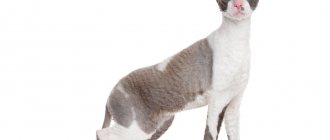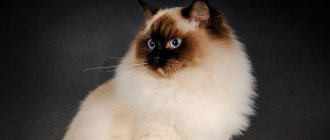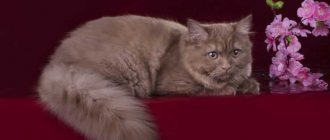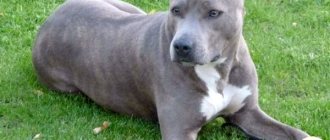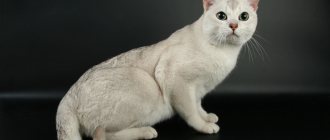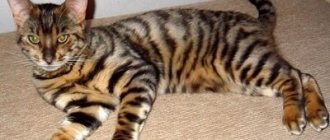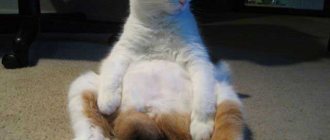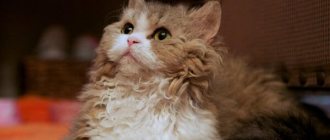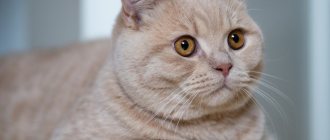Bengal cat
Do you want a breed with the appearance of a leopard and the demeanor of a house cat? Then, without a doubt, get a Bengal cat, bred by crossing domestic and wild Bengal cats. Bengals have stunning coat colors that come in a variety of vibrant patterns: rosettes, spots, or even merle patterns (where one or more colors are mixed into the base coat color).
Bengal breed
The homeland of Bengals is America. It was there that they were bred by obtaining a hybrid of an Asian wild leopard and domestic cats. This experiment is believed to have begun in the 1960s. Characteristics of Bengal cats are excellent immunity and endurance. But the stomach is a weak point that malfunctions if not fed correctly.
Bengals have the following distinctive features:
- Large size from 50 to 80 cm, conical tail. The weight of a female is up to 5 kg, and a male’s weight is up to 8 kg.
- The head is wedge-shaped, small.
- A wide nose is a wild sign.
- The ears are medium in size, rounded at the ends. Their base is quite wide.
- The color of almond-shaped or oval-shaped eyes is very different: green, brown, yellow shades.
There are a number of differences that make the Bengal cat different from other breeds: plasticity along with predatory habits, love for water, unique coloring, similar to a leopard print. You can buy a Bengal cat at a cattery or from breeders. Its price ranges from 30 to 150 thousand rubles, which depends on the class.
The nutrition of a Bengal cat depends on its age. The kitten eats 4 times a day, and as the cat grows older, it switches to two meals a day. The stomach of Bengal cats cannot digest any food taken from the owners' table. You need to buy ready-made industrial food.
Grooming for Bengals is minimal, and these animals themselves are clean. You need to comb them, trim their nails to 3 mm, and clean their ears. They are not afraid of water procedures. The nature of Bengal cats is not fearful towards other animals.
The breed is distinguished by its ability to train, remembers commands, and listens carefully. At the same time, playfulness constantly appears.
Bombay
If you do not take into account the calm, patient and friendly nature of the Bombay, you might think that he is a miniature copy of the black panther. The breed's exotic appearance was achieved by crossing a sable Burmese cat with a black American Shorthair, earning it the nickname "the patent leather baby with the new penny eyes."
The most popular breeds of domestic cats with leopard spots
Among the most popular breeds of spotted cats bred through selective breeding are the following.
Egyptian Mau
Egyptian cats were depicted on the walls of ancient pyramids and have been known in the world for more than 5,000 years. All modern representatives of this species trace their ancestry to Egyptian cats given to the Russian princess Natalya Trubetskoy. In 1955, the kittens obtained from them took part in the Rome Exhibition and won well-deserved recognition. After emigrating to the United States, Trubetskoy founded the Fatima nursery, where she began deliberately breeding cats similar to leopards.
Despite the changes that have occurred, Egyptian cats still have a hunting instinct and can easily cope with rodents in their homes.
Representatives of the Egyptian cat have 4 types of color, but the letter “M” formed by stripes on the animal’s forehead is considered a special feature. The eyes of Mau cats are a beautiful emerald shade, although in childhood they can be of any color.
They are very smart, independent and at the same time flexible creatures. These are very sociable animals that quickly get used to one owner. They recognize and obey only him, but are friendly with all family members. This factor must be taken into account when choosing a breed. If the owner is absent for a long time, the cat may become depressed, stop listening, and become aggressive.
Maine Coon
These felines appeared in the American state of Maine at the end of the 19th century. She was quickly registered and began to take part in exhibitions.
The cat is big and strong. It tolerates harsh environmental conditions well, thanks to its long, thick coat. The animal’s paws are dressed in noticeable “pants,” which are one of the signs of the breed. Also notable are the bushy tail and the fur around the neck, forming a real collar. Maine Coons are considered the largest cats in the world.
Maine Coons need to be allowed to roam freely. It is very good to provide a bath with water in the enclosure. These are rare swimmers among cats.
Kurzhaar
The American Shorthair is a spontaneous cross between a European Shorthair and an American Shorthair. This happened in the 17th century, when the colonists arrived in America. The breed was approved in 1950.
Egyptian Mau
Egyptian Mau cats can run at speeds of up to 50 km per hour, making it difficult for them to sit still long enough for you to notice their natural spotted coloring and exotic markings around the eyes. Researchers believe the breed originated in Egypt at least 3,000 years ago, and likely descended from African wild cats.
How much does a leopard kitten cost?
Bengal kittens cost from 30 to 100 thousand rubles, depending on the color and strength of the phenotype of a particular animal. Some sellers divide them into classes based on genetic strength.
Ashera prices start at $22,000. Royal ones cost $125,000 and appear no more than 4 times a year.
a Savannah kitten anywhere for less than $4,000.
The cost of the Serengetti is low due to the fact that the breed does not have a classical standard and strict requirements for the characteristics of animals. The average price is 35,000 rubles, which
The cost of a Kanaani kitten is from 90,000 rubles.
The price of the Arabian Mau starts at 40,000 rubles.
The most inexpensive among leopard cats is the Asian tabby. Its average price is $1,000.
Savannah
A relatively new breed that was recognized by the Cat Fanciers' Association in 2012, the Savannah is known for its unusual appearance. Large, tall ears are located on the top of the head. The savanna is also characterized by a long neck, long legs and a short, thick tail. In addition, these cats have exotic spotted and striped coats. And this is not surprising, the wild appearance of the savannah was achieved by crossing the African serval with a domestic cat.
Necessary care
You should care for your exotic pet in the same way as any ordinary domestic cat, following simple rules. You just need to make allowances for the fact that the domestic Savannah cat is quite large and does not like to sit at home for a long time. It’s unlikely that a resident of a one-room apartment would think of choosing a pet that costs a couple of other similar apartments, but it’s worth clarifying: the savannah needs space and frequent long walks in the fresh air. They also just love to swim, so they need to be provided with access to a pool or the nearest (clean!) body of water. Therefore, keeping such a cat requires the presence of a country house and necessarily a private house, where the animal can feel free and comfortable.
Somali cat
Descended from the Abyssinian cat, the longhaired Somali also has the appearance of an African wild cat and, thanks to its bushy tail, can be mistaken for a fox. Like their related shorthaired Abyssinians, Somali cats are also intelligent, curious and very active animals. If you are looking for a calm cat for your lap, then the Somali breed is not for you.
Toyger
Thanks to its orange color with black or brown stripes and muscular body, the toyger can easily be confused with a real tiger cub. Fortunately, this breed is much nicer (and safer) to humans than a tiger cub and is known for its sweet, calm and friendly nature. The wild appearance of the Toyger was obtained by crossing a Bengal and a domestic tabby shorthair cat.
Arabian Mau
It also has spots, and the coat itself has no undercoat. Color ranges from white with black spots to black without spots. The main color of the breed is brown or gray with patterns.
This cat cannot claim the title and is only temporarily recognized, but in 2008 it was standardized. For the Middle East, this animal is native. Characteristics: Large size, muscular, high legs, tapered tail. The paws are rounded, and large ears are located above the head. Males are larger than females, weighing up to 8 kg.
The Arabian Mau has oval eyes that match the color of its coat. Friendly character: accompanies owners, plays with children. Care - weekly brushing, ear cleaning, walks.
The breed standards are as follows:
- A muscular body with long legs cannot be called very slender.
- The coat is adjacent to the body, hard, and in adult specimens silkiness is excluded.
- The coloring is very diverse: black spots on a white background and white on black, tabby (pattern on the body), gray and brown tones.
Housey
This is a relatively young cat breed that was created by crossing a domestic cat with a wild jungle cat (Felis chaus). They can grow to almost a meter in length and weigh 4-7 kilograms or more. As with other hybrid Savannah or Bengal cats, male Housies from the first few generations are usually sterile, with the F4 and F5 generations considered the most suitable for showing.
Serengeti
The goal of breeding the Serengeti breed was to create a cat that resembled the wild Serval, but did not contain any of its ancestry. The first Serengeti was created by Karen Sauzman in 1994 by crossing a Bengal and an Oriental cat. Subsequent offspring were crossed with many other types of cats to perfect the breed. However, the Serengeti ancestry includes genes from the wild Bengal cat, which was used to create the domestic Bengal cat. Cats of this breed have long ears and legs, like a serval. They are very mobile, active, and sociable.
